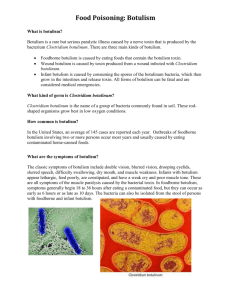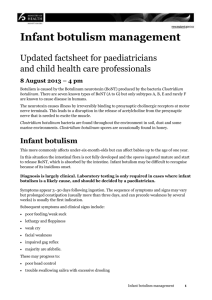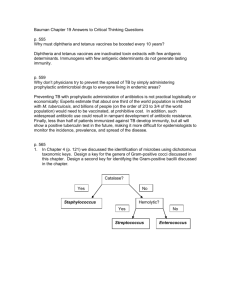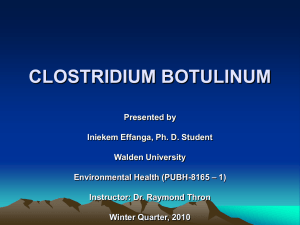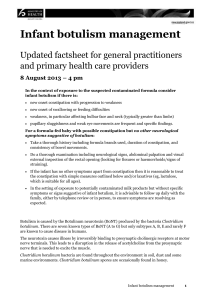Botulism
advertisement
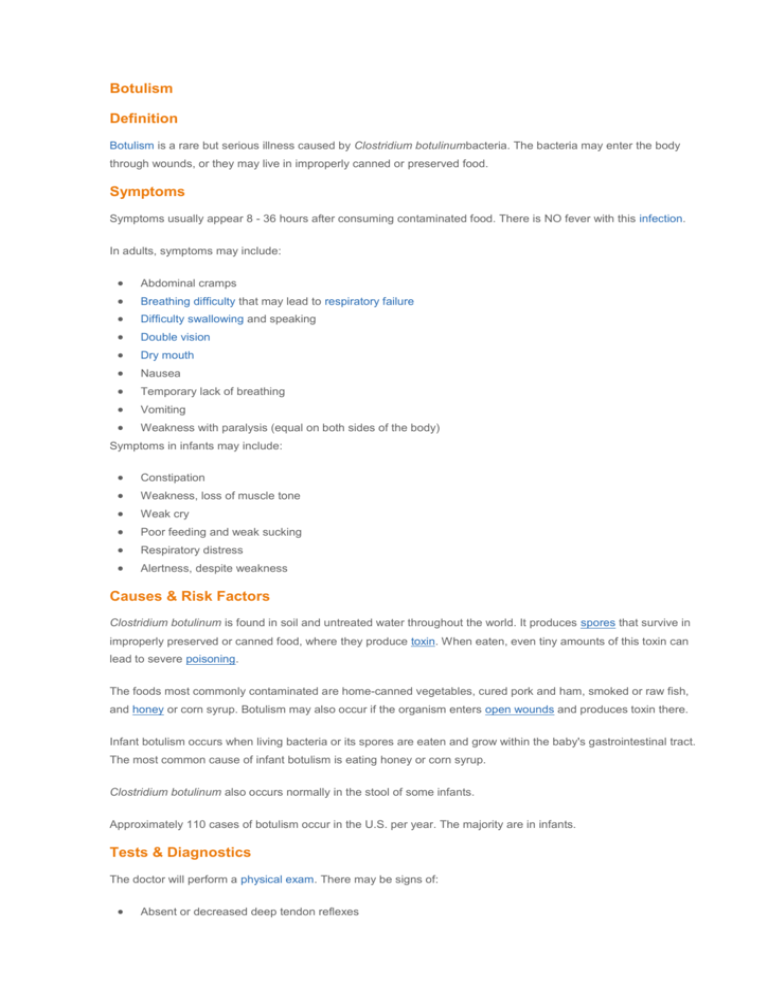
Botulism Definition Botulism is a rare but serious illness caused by Clostridium botulinumbacteria. The bacteria may enter the body through wounds, or they may live in improperly canned or preserved food. Symptoms Symptoms usually appear 8 - 36 hours after consuming contaminated food. There is NO fever with this infection. In adults, symptoms may include: Abdominal cramps Breathing difficulty that may lead to respiratory failure Difficulty swallowing and speaking Double vision Dry mouth Nausea Temporary lack of breathing Vomiting Weakness with paralysis (equal on both sides of the body) Symptoms in infants may include: Constipation Weakness, loss of muscle tone Weak cry Poor feeding and weak sucking Respiratory distress Alertness, despite weakness Causes & Risk Factors Clostridium botulinum is found in soil and untreated water throughout the world. It produces spores that survive in improperly preserved or canned food, where they produce toxin. When eaten, even tiny amounts of this toxin can lead to severe poisoning. The foods most commonly contaminated are home-canned vegetables, cured pork and ham, smoked or raw fish, and honey or corn syrup. Botulism may also occur if the organism enters open wounds and produces toxin there. Infant botulism occurs when living bacteria or its spores are eaten and grow within the baby's gastrointestinal tract. The most common cause of infant botulism is eating honey or corn syrup. Clostridium botulinum also occurs normally in the stool of some infants. Approximately 110 cases of botulism occur in the U.S. per year. The majority are in infants. Tests & Diagnostics The doctor will perform a physical exam. There may be signs of: Absent or decreased deep tendon reflexes Absent or decreased gag reflex Eyelid drooping Muscle function/feeling loss Paralyzed bowel Speech impairment Urine retention with inability to urinate Blood tests can be done to identify the toxin. A stool culture may also be ordered. Lab tests can be done on the suspected food to confirm botulism. Treatments Botulinus antitoxin is given. Breathing trouble requires hospitalization. The health care team will establish aclear airway and provide supportive therapy. A tube may be inserted through the nose or mouth into the windpipe to provide an airway for oxygen. A breathing machine may be needed. Intravenous fluids can be given when the patient has swallowing difficulties. A feeding tube may be inserted in the nose. Cases of botulism are reported to state health authorities or the U.S. Centers for Disease Control and Prevention by health care providers so that the contaminated food can be removed from stores. Antibiotics are often given, but have not been shown to always be beneficial. Drugs Older children and adults with botulism are sometimes treated with an antitoxin derived from horse serum that is distributed by the Centers for Disease Control and Prevention. The antitoxin (effective against toxin types A, B, and E) inactivates only the botulinum toxin that is unattached to nerve endings. Early injection of the antitoxin, ideally within 24 hours of onset of symptoms, can preserve nerve endings, prevent progression of the disease, and reduce mortality. Unfortunately, infants cannot receive the antitoxin used for adults. For them, human botulism immune globulin (BIG) is the preferred treatment. It is available in the United States through the Infant Botulism Treatment and Prevention Program in Berkeley, California. BIG neutralizes toxin types A, B, C, D, and E before they can bind to nerves. This antitoxin can provide protection against A and B toxins for approximately four months. Though many infants recover with supportive care, BIG cuts hospital stay in half and, therefore, reduces hospital costs by 50 percent as well. Aside from the specific antitoxin, no therapeutic drugs are used to treat botulism. Antibiotics are not effective for preventing or treating botulism because the Clostridium group of toxins are not sensitive to them. In fact, antibiotic use is discouraged for infants because bacteria could potentially release more toxin into a baby's system as they are killed. Antibiotics can be used, however, to treat secondary respiratory tract and other infections. Complications Aspiration pneumonia and infection Long-lasting weakness Nervous system problems for up to 1 year Respiratory distress Prevention NEVER give honey or corn syrup to infants younger than 1 year old -- not even just a little taste on a pacifier. Prevent infant botulism by exclusively breastfeeding, if possible. Always throw away bulging cans or foul-smelling preserved foods. Sterilizing home-canned foods by pressure cooking at 250 degrees Fahrenheit for 30 minutes may prevent botulism. Keep foil-wrapped baked potatoes hot or in the refrigerator, not out in room temperature. Botulism Definition By Mayo Clinic staff Botulism is a rare but serious condition caused by toxins from bacteria called Clostridium botulinum. Botulism comes in three main forms: Infant botulism. This most common form of botulism begins after Clostridium botulinum bacterial spores grow in a baby's intestinal tract. It typically occurs between the ages of 2 and 6 months. Food-borne botulism. The harmful bacteria thrive and produce the toxin in environments with little oxygen, such as in canned food. Wound botulism. If these bacteria get into a cut, they can cause a dangerous infection that produces the toxin. Because all types of botulism can potentially cause death, all types of botulism are considered medical emergencies. Symptoms By Mayo Clinic staff Signs and symptoms of food-borne botulism typically begin between 12 and 36 hours after the toxin gets into your body. If infant botulism is related to food, such as honey, problems will generally begin within this time frame, too. However, the symptoms of wound botulism typically start about 10 days after you're infected by the bacteria. Food-borne and wound botulism Signs and symptoms of food-borne and wound botulism include: Difficulty swallowing or speaking Facial weakness on both sides of the face Blurred vision Drooping eyelids Trouble breathing Nausea, vomiting and abdominal cramps (only in food-borne botulism) Paralysis Infant botulism Constipation (often the first sign) Floppy movements due to muscle weakness, and trouble controlling the head Weak cry Irritability Drooling Drooping eyelids Tiredness Difficulty sucking or feeding Paralysis Certain signs and symptoms usually aren't present with botulism, including no elevation in blood pressure or heart rate, no confusion and no fever. However, fever is sometimes present with wound botulism. When to see a doctor Seek urgent medical care if you suspect that you have botulism. Early treatment increases your chances of survival. Seeking medical care promptly may also serve to alert public health authorities, who can keep other people from eating contaminated food. Causes By Mayo Clinic staff Infant botulism Babies get infant botulism after consuming spores of the bacteria, which then grow and multiply in the intestine and make toxins. The source of infant botulism may be honey, but is more likely to be exposure to soil contaminated with the bacteria. Food-borne botulism The source of food-borne botulism is often home-canned foods that are low in acid, such as green beans, corn and beets. A common source of the illness in Alaska is fermented seafood. However, the disease has also occurred from chili peppers, baked potatoes and oil infused with garlic. When you eat food containing the toxin, it disrupts nerve function, causing paralysis. Wound botulism When C. botulinum bacteria get into a wound — possibly caused by an injury you might not notice — they can multiply and produce toxin. Wound botulism has increased in recent decades in people who inject heroin, which can contain spores of the bacteria. Some people have also gotten botulism from inhaling the spores from cocaine. Are there benefits to botulinum toxin? You might wonder how something so toxic could ever be beneficial, but scientists have found that the paralyzing effect of botulinum toxin makes it useful in certain circumstances. Botulinum toxin (Botox, Myobloc) can be an effective medication when used in very small amounts. Botulinum toxin has been used to reduce facial wrinkles by preventing contraction of muscles beneath the skin, and for medical conditions, such as eyelid spasms and severe underarm sweating. However, there have been rare occurrences of serious side effects, such as muscle paralysis extending beyond the treated area, with the use of botulinum toxin for medical reasons. Complications By Mayo Clinic staff Because it affects muscle control throughout your body, botulinum toxin can cause many complications. The most immediate danger is that you won't be able to breathe, which is the most common cause of death in botulism. Other complications may include: Difficulty speaking Trouble swallowing Long-lasting weakness Shortness of breath Preparing for your appointment By Mayo Clinic staff You may first see your primary care doctor. However, you'll likely be sent to the hospital for immediate treatment. At the hospital, you'll probably also see a doctor who specializes in neurology (neurologist) or infectious diseases. What you can do Bring any medications you take with you, and let your doctor know about any vitamins or supplements that you're taking. Write down questions to ask your doctor. Although you may not have time to write down questions before your first appointment, write down any questions you want to ask at your follow-up appointments. For botulism, some basic questions to ask your doctor include: How did I get botulism? Will I have any lasting problems? What types of side effects can I expect from treatment? Are there any dietary restrictions that I need to follow? How can I prevent this from happening again? In addition to the questions that you've prepared to ask your doctor, don't hesitate to ask questions any time you don't understand something. What to expect from your doctor Your doctor is likely to ask you a number of questions, such as: When did you first begin experiencing symptoms? Have your symptoms been continuous or occasional? Have you or your child eaten any canned food recently? If your infant is ill, has he or she consumed honey? Did anyone else eat the food suspected of making you ill? Tests and diagnosis By Mayo Clinic staff To diagnose botulism, your doctor will check you for signs of muscle weakness or paralysis, such as drooping eyelids and a weak voice. Your doctor will also ask about the foods you've eaten in the past few days, and ask if you may have been exposed to the bacteria through a wound. A blood test can confirm the presence of the toxin. In cases of possible infant botulism, the doctor may ask if the child has eaten honey recently and has had problems such as constipation and sluggishness. Analysis of stool or vomit for evidence of the toxin may help confirm an infant or food-borne botulism diagnosis, but because these tests may take days, your doctor's clinical examination is the primary means of diagnosis. Treatments and drugs By Mayo Clinic staff For cases of food-borne botulism, doctors sometimes clear out the digestive system by inducing vomiting and giving medications to induce bowel movements. If you have botulism in a wound, a doctor may need to remove infected tissue surgically. Antitoxin If you're diagnosed early with food-borne or wound botulism, injected antitoxin reduces the risk of complications. The antitoxin attaches itself to toxin that's still circulating in your bloodstream and keeps it from harming your nerves. The antitoxin cannot, however, reverse any damage that's already been done. Antitoxin is not, however, recommended for cases of infant botulism, since it doesn't affect the diseasecausing germs in the baby's digestive system. A treatment called botulism immune globulin is used to treat infants. Breathing assistance If you're having trouble breathing, you will probably need a mechanical ventilator. The ventilator forces air into your lungs through a tube inserted in your airway through your nose or mouth. You may remain on the ventilator for up to several weeks as the effects of the toxin gradually lessen. Rehabilitation As you recover, you may also need therapy to improve your speech, swallowing and other functions affected by the disease. Prevention By Mayo Clinic staff Use proper canning techniques Be sure to use proper techniques when canning foods at home to ensure that any botulism germs in the food are destroyed: Pressure cook these foods at 250 F (121 C) for at least 30 minutes. Consider boiling these foods for 10 minutes before serving them. Prepare and store food safely Don't eat preserved food if its container is bulging or if the food smells spoiled. However, taste and smell won't always give away the presence of C. botulinum. Some strains don't make food smell bad or taste unusual. If you wrap potatoes in foil before baking them, eat them hot or store them in the refrigerator — not at room temperature. Store oils infused with garlic or herbs in the refrigerator. Infant botulism To reduce the risk of infant botulism, avoid giving honey — even a tiny taste — to babies under the age of 1 year. Wound botulism To prevent wound botulism and other serious bloodborne diseases, never inject or inhale street drugs.

